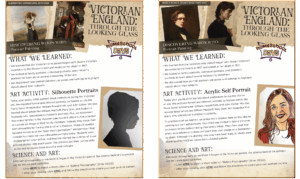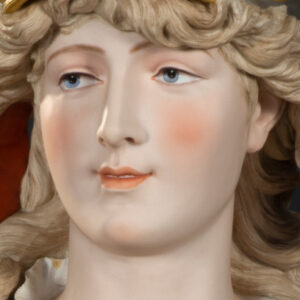St. Gabriel the Archangel
Unknown Pre-Raphaelite, 19th century
Below the image, click play to listen.
Oil on canvas, 1880; signed lower left
English, 1837–1898
The Victorian period is known for its diverse richness as an era of scientific and technological innovation, industry, the development of the novel, the rise of the middle class, incredible social reforms, the expansion of the British empire, and . . . the golden age of English painting.
For us to appreciate the breadth and influence of art during the time, Denys Brook-Hart writes, “the galaxy of artistic talent and endeavour which rose to its peak in the 19th century in Britain had not previously been rivalled in any other country or period. For proof of sheer quantity one needs only to mention the 25,000 professional artists who exhibited in London alone. For quality it is amply sufficient to quote the names of Turner and Constable in their places at the head of a long list of distinguished and truly marvellous artists, many of whom had the rank of genius.”
While being a member and/or an exhibitor of the Royal Academy (founded during King George III’s reign) was considered the height of honor, many other art societies developed before and during Victoria’s rule to train and exhibit artists. Approved by King George IV in 1824, the Royal Society of British Artists (RBA) was organized and began to exhibit annually. Painter Laslett John Pott later became an elected member.
Pott was a child prodigy. Biographers Clare Erskine Clement and Laurence Hutton relate that he “drew cleverly when not more than five years old.” His skill, particularly as a history painter, gave him opportunity to exhibit at least 40 paintings at London’s Royal Academy, beginning in 1860 when he was only twenty-three and including M&G’s painting, The Trial of Queen Catherine in 1880.
Here, Pott conflates two parts of the historical telling into one scene. According to the eyewitness account of Cardinal Wolsey’s gentleman-usher and biographer George Cavendish, Catherine was called to appear before the Legatine Court at Blackfriars where Henry sat upon a canopied dais to watch. Rather than addressing the court, which she felt would legitimize their purpose, she made a rational and impassioned appeal on knee to her seated husband only, then arose, curtsied to the king, and left the hall. The council summoned her to return, but she refused on the grounds that they had already decided against her. Cavendish recounts that later Wolsey met with Catherine for further discussion; however, she strongly and loudly rebuked him for his action motivated by political ambition.
The painting dramatizes the nobility of Catherine of Aragon. She holds her skirt as if she has just risen from kneeling and is preparing to leave after she finishes confronting those from church and state who would declare her marriage of twenty-four years to Henry VIII void—namely, Cardinal Wolsey (standing at the table) and the pope’s emissary, Cardinal Lorenzo Campeggio (seated).
Catherine, the youngest daughter of King Ferdinand and Queen Isabella of Spain, had married Arthur, heir to England’s throne, when she was fifteen. Four months later she was a widow. When she married the next heir to the throne, Henry, she was twenty-three, he only eighteen. Her primary duty as queen, to produce a male heir, was tragically unsuccessful; although she bore six children, none except Mary lived longer than a few months.
Henry argued that the marriage was null since he had violated church law by marrying his brother’s widow, although the pope had granted approval for the marriage. Now desperate for a male heir and enamored with the young Anne Boleyn, the king pressured Wolsey and Campeggio to convince Catherine to agree to their demands. After her refusal, Henry took matters into his own hands and declared himself, not the pope, head of the Church in England, annulled the marriage, and married Anne (who only produced a daughter—Elizabeth). Of course, Henry in pursuit of a male heir found reasons to escape his marriage to Anne, then Jane Seymour, and three subsequent wives.
Erin R. Jones, Executive Director
Sources:
Johnson, Jane. Works Exhibited at the Royal Academy of British Artists 1824-1893 and the New English Art Club 1888-1917w: An Antique Collectors’ Club Research Project. 1974
Erskine, Clara and Hutton, Laurence. Artists of the Nineteenth Century and Their Works. A Handbook Containing Two Thousand and Fifty Biographical Sketches. Boston, 1875
Graves, Algernon. A Dictionary of Artists Who Have Exhibited Works in the Principal London Exhibitions of Oil Paintings from 1760 to 1880. 1884.
Published 2025

September: Discovering Who’s Who: Portrait Painting
Click HERE to access the Elementary pdf. Click HERE to access the Middle School pdf.
October: Sharing Stories: Children’s Book Illustrators
Click HERE to access the Elementary pdf. Click HERE to access the Middle School pdf.
November: Furry Friends and Fearsome Beasts: Animal Painters
Click HERE to access the Elementary pdf. Click HERE to access the Middle School pdf.

Join us for an exploration of Victorian England—a golden age of dazzling personalities, painting styles, and techniques! Students (ages 5-14) will discover how Victorian artists shaped not only their world but our own. Each 75-minute lesson is interactive and includes a related art activity. Don’t miss out on this opportunity to learn and create. As Alice in Lewis Carroll’s classic says: “What is the good of a book (or a world) without pictures?”
Parent attendance is optional. Review our FAQs, which cover arrival and even co-op questions.
Registration: Register HERE.
Location: Mack Building (on the campus of Bob Jones University)
Fees per Lesson: Children–$10; adults–$3
Further your exploration of the era at home through M&G’s FREE electronic activity resource sheets HERE.
Thursday at 9:30AM and 2PM
Friday at 9:30AM, Noon, and 2PM
Friday at 9:30AM, Noon, and 2PM
Registration for Spring semester will open in December.
Enjoying a Laugh: Caricatures and Limericks
Discovering Nature: Landscape and Still Life Paintings
The Imaginative World: Prominent Women Artists
Homeschool Days is part of Arts Encounter, M&G’s K-12 arts programming.
Victorian artist, Eyre Crowe does a masterful job of recreating that moment in the town of Wittenberg, Germany that set in motion the Protestant Reformation.
Oil on Canvas, signed lower left
English, 1801-1866
During the Victorian era landscape painting became a major branch of English art, and a burgeoning preference for the genre can be seen in the Royal Academy’s mid-century exhibitions. This popularity was due in part to the wide-ranging approach of English artists to the genre. In J.M.W. Turner’s romantic imagery, John Constable’s naturalistic scenes, and William Holman Hunt’s meticulously rendered flora and fauna, Victorians perceived anew the beauty, grandeur, and stunning diversity of the natural world. Through these artists, viewers also discerned that a landscape may be far more than an appealing backdrop.
In this work inspired by Act 1, scene 3 of Shakespeare’s Macbeth, the landscape carries the storytelling power of the scene. The chiaroscuro, colors, swirling lines, and frenetic brushwork all “speak.” In a very real sense, Train’s landscape functions as a personified antagonist in his visual narrative.
Macbeth and Banquo, two victorious warriors, arrive upon a wind-swept heath “at set of sun.” There, three witches give them seemingly encouraging news: Macbeth is informed that he will not only become Thane of Cawdor but also “king hereafter.” Likewise, Banquo is told that his progeny will one day rule. Both men are initially suspicious of the hags’ prophecies—until an entourage arrives to confirm that King Duncan has indeed named Macbeth Thane of Cawdor. With this news Macbeth begins to toy with not only embracing but also hastening the witches’ prophecies.
Banquo warns his friend:
. . .Oftentimes, to win us to our harm,
The instruments of darkness tell us truths,
Win us with honest trifles, to betray ’s
In deepest consequence.
Act 1, scene 3, ll. 124-128
However, the “fair tidings” have already set alight Macbeth’s ambition, kindling the “horrible imaginings” that foreshadow his descent into psychological and spiritual darkness. Before days end, Macbeth (goaded by his equally ambitious wife) will murder the rightful king.
Notice how Train uses atmospheric perspective to create a foreboding sky. His loose brushwork and subtle color blending create an illusion that the lowering storm clouds hovering over the witches are fast moving toward the blood red sun. Soon, what remains of the light will be “put out,” leaving the characters in darkness. The jagged terrain further accentuates Macbeth’s and Banquo’s precarious position. The implied diagonal line connecting these warriors to the witches further heightens the suspense. Notice that the witches on the left look down on Macbeth and Banquo who are “center stage.” This slightly elevated positioning insinuates their psychic dominance. In addition, the shadowy entourage approaching in the distance foreshadows that the witches’ first prophecy will soon be fulfilled, setting in motion the “horrible imaginings” spawned by Macbeth’s musings.
Although scholars continue to debate whether Shakespeare was a Christian, most agree that the “worlds” he creates reflect a clear understanding of the moral law and the human condition. In Shakespeare’s dramas a disregard for the divine order results not only in human suffering (turbulence among men) but also in upheaval in the natural world (tempestuousness in nature). It is not by chance, therefore, that Macbeth’s temptation takes place upon a storm-tossed heath. Nor is it surprising that following the murder of King Duncan raging storms spread across the land, daylight is entombed in darkness, and Duncan’s “beauteous and swift horses have turned wild, broken their stalls, and devoured one another.”
Shakespearean scholar David Bevington says that “Macbeth is in some ways Shakespeare’s most unsettling tragedy, because it invites the intense examination of the heart of a man who is well-intentioned in most ways but who discovers that he cannot resist the temptation to achieve power at any cost.”
One final intriguing detail is the existence of a similar work by Train titled Landscape with Three Mythological Women Stopping the Roman’s Army’s Advance. This work is dated in 1865 a year before the artist’s death. Although the painting has the same setting as M&G’s Macbeth, it is from a different vantage point. Perhaps Train was exploring how vantage point might alter mood. In any case, the 1865 landscape is less poignant and evocative in its narrative power.
Donnalynn Hess, Director of Education and Bella Vita Sanders, Research Intern
The Complete Works of Shakespeare, David Bevington
Victorian Painting, Christopher Wood
Published in 2025
Oil on panel, signed and dated lower right: A Scheffer 1849
Dutch, active in France, 1795-1858
Ary Scheffer first studied art with his parents, later studying at the Amsterdam Drawing Academy. When his father died, Scheffer moved with his family to study in Paris with the neoclassical painter Pierre Guerin which set Scheffer on the road to Romanticism. A year later, he debuted at the Royal Academy’s Salon Exhibition. Five years after the move, he won his first medal which garnered him patronage by a supporter of the royal family.
The French would call this work an étude—a study made of a model to reference and work out details for a later painting. As such, collectors consider them valuable works. A glance at his oeuvre (body of work) reveals that Scheffer uses this model repeatedly for the Christ figure in several of his works largely during his religious period at the end of his career. Dated 1849, M&G’s study likely influenced later works, such as The Temptation of Christ (1854) in the National Gallery of Victoria and perhaps Christ Weeping over Jerusalem (1849) in the Victoria & Albert Museum (which he repeated in an 1851 version at the Walters Art Museum).
Scheffer’s popularity did extend to England but with a marked division in how the British received his works. The members of the Pre-Raphaelite Brotherhood, just at the start of their own movement (1848), varied in their reactions: William Holman Hunt did not approve, unlike Thomas Woolner. In fact, Hunt convinced D.G. Rossetti that Scheffer’s works were “worthless” (Morris 180).
The Royal Academy in London criticized nearly all the technical aspects of his work, especially his coloring, possibly feeling vulnerable from the acclaim that he was receiving in the industrial North. The growth in the middle class through textile factories in cities such as Manchester and Liverpool made art collecting a mark of affluence and social status. These “barons” were already comfortable with Europe due to product exportation; the importation of ideas from there was a natural consequence. Scheffer was championed by the author Elizabeth Gaskell and collected by the “intensely pious John Heugh” (Morris 186). John Ruskin called him “one of the heads of the mud sentiment school,” but admitted that Scheffer “does draw and feel very beautifully and deeply” (Morris 180).
So if technical excellence was not the draw, what was? Edward Morris states that “it was above all spiritual and emotional exaltation particularly in expression that Scheffer’s English friends admired in his art” (176). This Head of Christ evidences the coloring that drew criticism: the palette is limited to creams and browns with little distinction between Christ’s clothing and His skin. But Christ’s face is what draws attention. Kindness, introspection, firmness of purpose, along with a far-seeing gaze, create the impression that the God-man is on an eternal mission. “Emotional idealism” can easily cross the line into sentimentality, especially in religious works. However, the appeal to sentiment often leads to contemplation, a result that all artists desire. And anything more than a passing glance at Scheffer’s Head of Christ compels the viewer to ponder the Savior of the world.
Dr. Karen Rowe Jones, M&G board member
Work Cited:
Morris, Edward. French Art in Nineteenth-Century Britain. Yale UP, New Haven. 2005
Porcelain
French, 1860-1880
M&G’s magnificent porcelain bust of a female warrior presents the viewer with two fascinating mysteries.
 The bust has no signature or manufacture’s marks. The base does, but documented provenance of the piece, which dates to the mid-twentieth century, reveals that the base is not original to the sculpture. Experts have examined M&G’s bust and place its manufacture in France between 1860 and 1880. At that time similar, elaborately dressed busts were popular, and the techniques needed to produce the richly colored glazes for the clothing and accessories while leaving smooth, lightly colored biscuit porcelain for the skin and various details had been perfected. The contrast between the solid, smooth, glossy sections and the soft, matte texture of the biscuit sections heightens the visual interest of works like these.
The bust has no signature or manufacture’s marks. The base does, but documented provenance of the piece, which dates to the mid-twentieth century, reveals that the base is not original to the sculpture. Experts have examined M&G’s bust and place its manufacture in France between 1860 and 1880. At that time similar, elaborately dressed busts were popular, and the techniques needed to produce the richly colored glazes for the clothing and accessories while leaving smooth, lightly colored biscuit porcelain for the skin and various details had been perfected. The contrast between the solid, smooth, glossy sections and the soft, matte texture of the biscuit sections heightens the visual interest of works like these.
Paul Duboy (1830-1887), a French sculptor, exhibited his sculpture at the prestigious Paris Salon from 1853-1882. Duboy made and signed busts similar to M&G’s sculpture, which lacks his elaborate signature on its back. Yet, because of its similarity to his other works, authorities have suggested using “in the manner of” or “after” Paul Duboy.
From the pantheon of candidates, the personification of the French Republic has been suggested. During the French Revolution, Marianne embodied the qualities valued by French citizens: liberty, equality, fraternity, and reason. M&G’s bust, however, lacks the Phrygian cap, laurel wreath or spiked diadem, and other visual symbols attributed to Marianne.
The Greek goddess Athena is a more likely candidate. Zeus, the chief Greek deity, was her father. Legend tells that Athena sprang full-grown from Zeus’s forehead dressed in complete Greek armor. As the goddess of war, Athena participated in the Trojan War and has generally been portrayed with a spear or bow and arrows. She was also the goddess of domestic handicrafts, animal husbandry, and wisdom. Generally, she used her wisdom to supply warriors with the tactics, strategy, and inspiration needed to defeat enemies. Animal symbols associated with Athena include the owl and snake, both representing wisdom (she also cursed Medusa with hair of snakes), and the horse referencing her teaching man how to tame the animal. While an unusual artistic reference, perhaps the horses on M&G’s helmet symbolize this lore. The eagle-winged dragon atop M&G’s helmet, however, has no known Athenian reference.
 Another possible female warrior may be Minerva, the Roman version of Athena. The two share similar attributes, but the Roman goddess of war is usually depicted wearing an Attic helmet, which does not cover the face but often has ear guards, and may have decorative elements on top. Roman soldiers typically wore Attic helmets and variations were common after the fall of the Roman empire. M&G’s bust wears a greatly-modified and highly-decorated Attic helmet.
Another possible female warrior may be Minerva, the Roman version of Athena. The two share similar attributes, but the Roman goddess of war is usually depicted wearing an Attic helmet, which does not cover the face but often has ear guards, and may have decorative elements on top. Roman soldiers typically wore Attic helmets and variations were common after the fall of the Roman empire. M&G’s bust wears a greatly-modified and highly-decorated Attic helmet.
Virtually all artist renderings of both Athena and Minerva wear loose-fitting Greco-Roman garments, even when they wear armor. M&G’s bust is elaborately dressed and draped in the manner of many busts from the period of its manufacture. She also wears hints of decorative gold armor and a massive, ornate gold chain.
Some of the busts produced in this period are identified as famous individuals and with a name included on the sculpture. Most, however, are simply beautiful works of art with generic titles, not based on any specific individual. M&G’s bust may simply be a beautiful porcelain piece by an unknown, skilled artist depicting a female warrior.
The bust has presented more mysteries than answers. However, if you examine the piece closely you can be assured of two things: you will be impressed with its artistic quality and beauty, and you will gain a better understanding of the phrase “a porcelain complexion.”
Bill Pinkston, retired educator and M&G volunteer
Published 2024